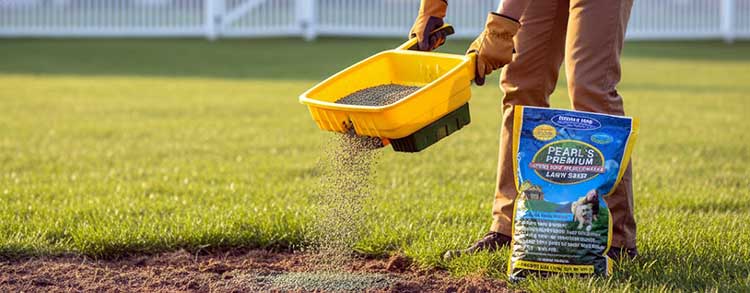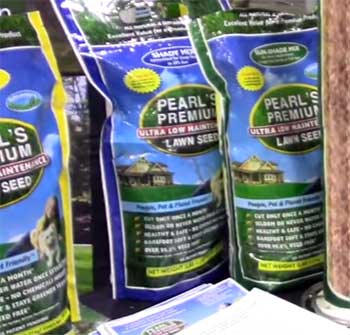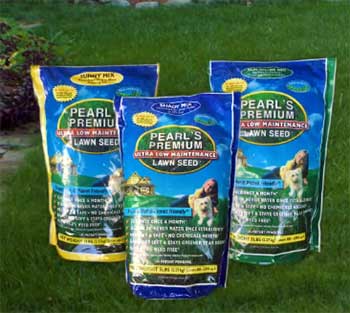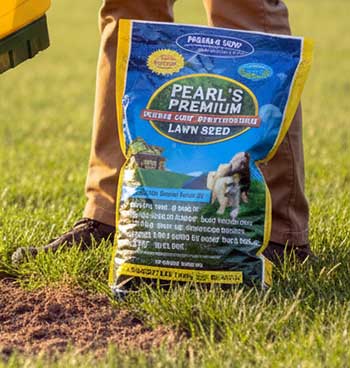Listen, if you’re tired of slaving away over a lawn that drinks more water than a marathon runner and demands weekly mows like a needy toddler, it’s time to grab a bag of Pearl’s Premium Grass Seed.
I’ve been there—staring at my patchy, thirsty yard, wondering why I signed up for this endless chore. This seed changed everything for me, turning my backyard into a lush, low-effort oasis that stays green without the drama.
You deserve that too: less hassle, more hammock time. Trust me, once you see how it thrives with minimal fuss, you’ll wonder why you waited. Go stock up today and reclaim your weekends.
My Hands-On Adventure With Pearl’s Premium Grass Seed

Last fall, my lawn was a sad, patchy mess—thirsty Kentucky bluegrass that mocked my watering efforts. A friend raved about Pearl’s Premium Grass Seed, promising deep roots and less work. Skeptical but desperate, I ordered a five-pound bag of Sunny Mix for my 1,000-square-foot backyard and got to it.
Prep was simple: I mowed low with a dull blade to tear up old grass, raked debris, and spread a thin compost layer. My soil tested acidic, so I added lime. Seeding was a breeze—15 seeds per square inch with a broadcast spreader, lightly raked in.
Watering was key: twice-daily mists kept the top inch moist, not soggy. By day 10, green sprouts appeared, growing steadily. At three weeks, two-inch blades stood strong, so I held off mowing to let roots dig deep.
A month later, my yard was vibrant—no bare spots, just soft green turf. I mowed at four inches, cutting to three, leaving clippings to mulch naturally. A test dig showed roots plunging 12 inches, unlike my old grass’s shallow sprawl.
Watering dropped to weekly, then nearly nothing as fall rains kicked in. Winter hit, and it stayed green through frost, no browning. Weeds tried sneaking in spring, but the dense turf shut them down—no chemicals needed.
Now, my kids play without wrecking it, the dog romps freely, and I relax, not chained to a hose. Setup took effort, but the payoff? A forgiving, thriving lawn. If you want less sweat and more chill, this seed’s your ticket.
What I Love Most: The Standout Pros of Pearl’s Premium
Let’s get real—you’re probably wondering if Pearl’s Premium lives up to the hype, right? As someone who’s wrestled with finicky lawns for years, I can tell you: yes, and then some. This stuff isn’t just another bag of seeds; it’s a game-changer for anyone craving a yard that works with you, not against you.
I’ve pulled together the biggest wins from my own yard battles, plus chats with neighbors who’ve switched over. These aren’t fluffy promises—they’re what you’ll notice week after week.
- Massive Water Savings That’ll Cut Your Bills

Picture this: your sprinkler running for hours, guzzling thousands of gallons a summer, all for grass that still wilts under July heat.
Sound familiar?
With Pearl’s Premium, I slashed my watering by 75% after the first month.
Those deep roots—up to three feet in my test digs—tap into moisture your old shallow-rooted stuff never reaches.
In my shady corner, where bluegrass always parched out, this blend sips just enough to thrive.
You won’t stare at your water meter in dread anymore; instead, you’ll pocket the savings and maybe treat yourself to that new grill. It’s eco-smart too—less runoff means healthier soil and happier pollinators buzzing around.
- Mowing Freedom: Once a Month, Tops
Oh man, the liberation of infrequent cuts. Traditional grass demands weekly whacks, turning your Sunday into a sweat fest. But Pearl’s grows at a quarter the speed, so I grab the mower maybe every four weeks.
It reaches about four inches, then gracefully flops over without clumping or yellowing. No more racing the growth spurt; just set it and forget it. My arms thank me—no more blisters from endless pushes—and the gas savings add up.
Plus, that slower blade action means less wear on your equipment. If you’re like me and view mowing as a necessary evil, this pro alone makes the switch worthwhile.
- Chemical-Free Vibes for Family and Planet
Here’s where it hits home: no more worrying about kids rolling in fertilizer residue or pets tracking pesticides inside. Pearl’s Premium skips the chems entirely—zero fertilizers, herbicides, or bug sprays needed.
It builds its own resilience through that smart seed mix of fescues, rye, and bluegrass that crowd out invaders naturally. In my yard, weeds popped up early, but by mid-season, the turf was too thick for them to gain ground.
I sleep better knowing my little one’s picnics are toxin-free, and the earthworms are partying underground without poison scares. It’s that quiet confidence: a safe, sustainable space you actually use.
- Year-Round Green That Defies Seasons
Ever envy those flawless lawns in magazines, green through chill and scorch? Pearl’s delivers. My patch held a bright emerald through a quirky New England winter—no snow blanket required, thanks to those hardy fescues. Spring bounce-back was effortless; no reseeding patches like before.
In hot spells, it shrugs off drought better than neighbors’ thirsty plots. You get consistent curb appeal without the off-season blahs, making your home feel polished 365 days. It’s like the yard’s got built-in antifreeze and sunscreen.
- Tough Roots for Everyday Life
Life with a family means rough-and-tumble yards—soccer games, dog zoomies, backyard BBQs. Pearl’s handles it with roots that anchor deep and recover fast. After a kid’s slip-n-slide marathon, mine bounced back greener, no ruts or bare knees.
It’s softer underfoot than stiff bluegrass, too—perfect for barefoot lounging. And in traffic zones like my driveway edge, it outcompetes crabgrass without backup from sprays. You build a resilient play zone that lasts, not one that needs constant babying.
These perks stack up to a yard that’s more ally than adversary. I’ve shared bags with friends, and they’re all converts now—less time fussing, more time living. If your current setup leaves you exhausted, imagine flipping that script.
Potential Drawbacks of Pearl’s Premium Grass Seed
No product’s perfect, and Pearl’s Premium has its quirks—stuff I bumped into that might trip you up too. I’m sharing these not to scare you off, but so you go in eyes wide open, tweaking as needed for your spot. From my trial-and-error, here’s the honest scoop on what isn’t all sunshine.
- Slower Start Than Quick-Fix Seeds

You plant, water like clockwork, and… crickets for a week longer than expected.
Germination took me 10 days, not the zippy three from rye-heavy mixes.
If you’re itching for instant green, this demands patience—those deep roots prioritize underground hustle over top-speed sprouts.
Early on, I second-guessed myself, but pushing through paid off. Just know: if your timeline’s tight for an event, plan ahead or patch with something faster.
- Best in Cooler Climes, Not Heat Havens
Living up north? You’re golden. But if you’re south of the Mason-Dixon, brace for extra effort. My southern-vacay pal tried it and needed consistent irrigation through summers—those fescues wilt faster in relentless scorch.
It’s not built for tropical vibes; bluegrass or Bermuda might edge it out there. Test your zone first—if temps spike over 85°F regular, this could stress without shade or supplements.
- Unique Texture That’s Not for Everyone
Soft and fine? Yes. But it’s not the plush, uniform carpet of classic bluegrass. Mine has a meadow-like flop when unmowed—charming to me, but my neat-freak neighbor called it “wild.” If you crave that manicured golf-course sheen, this leans more natural, less formal.
Adjust expectations; it’s beauty in a laid-back way, thriving on neglect where others falter.
- Upfront Investment in Prep and Seed
Bags run pricier than bargain-bin stuff—about seven bucks a pound—and initial soil tweaks (lime, compost) add up. Scalping and aerating? Non-negotiable for best results, eating a weekend. I skimped once on raking and regretted thin spots. If budget’s tight, start small; scale as you see the long-game wins.
- Weed Watch in Year One
It crowds weeds out eventually, but year one? A few dandelions crashed the party. Hand-pulling worked, but if your yard’s a jungle, plan spot treatments (organic only). Patience here—by season two, density handles it solo.
These aren’t deal-breakers; they’re just the reality check that keeps expectations grounded. Weigh them against the ease that follows, and you’ll see why I still rave.
Also Read: Is United Seeds Worth It?
Tips For Pearl’s Premium Grass Seed
Alright, you’ve got the seed down—now let’s talk keeping that beauty humming without turning it into a job. I learned the hard way: neglect the basics, and even Pearl’s wonders fade. But follow these, and you’ll coast.
Drawing from my seasons with it, plus tweaks from local pros, here’s your playbook. Think of it as gentle nudges, not boot camp.
- Watering Wisdom: Less is More Once Rooted

Newly seeded?
Mist daily—top inch damp, never soaked—to coax those sprouts.
I set a timer for 10-minute sessions morning and eve, dodging midday burn.
Once up (four weeks in), ease to deep soaks weekly if rain skips—aim for an inch total, roots probing six inches down.
Probe with a screwdriver; if it slides easy, you’re good.
In my drought-y stretch, I skipped altogether some weeks, and it perked fine. Pro tip: mulch lightly with straw at plant to lock moisture, cutting evaporation by half.
Overdo it? Muddy mess. Underdo? Stressed blades. Find your rhythm, and watch bills drop.
- Mowing Mastery: High and Infrequent
Cut at three inches minimum—taller shades soil, starving weeds. I wait till four, snip one-third off with sharp blades for clean tears, not rips. Mulch clippings back in; they feed roots naturally. Monthly rhythm suits Pearl’s slow vibe—no weekly grind.
After rain, dry fully first to avoid clogs. In growth spurts (spring fever), sneak an extra if it hits five, but rare. This habit built my turf’s toughness; short cuts invite trouble like brown patches.
- Fertilizing Finesse: Organic and Occasional
Skip synthetics—Pearl’s hates ’em. I top-dress compost yearly, spring or fall, quarter-inch layer raked in. It feeds microbes, not just plants, yielding steady green without spikes. Soil test every other year; if low nitrogen shows, a light organic boost (like corn gluten) does wonders.
Over-fertilize? You burn roots, undoing the low-maintenance magic. My lazy approach: one annual dump, and it hums. Ties into carbon sequestration too—your yard pulls CO2 like a champ.
- Weed Warfare: Prevention Over Battle
Aerate twice yearly—spring and fall plugs—to breathe soil, letting roots spread. I rent a core machine cheap; it’s game-changing for density. Overseed thin spots fall at heavy rates (eight pounds per thousand square feet) to smother invaders.
Hand-yank biggies early; by year two, competition wins. No sprays needed—I’ve gone chemical-free, and dandelions quit crashing. High mows help too, blocking light to seedlings. Patience pays; my yard’s now a weed fortress.
- Seasonal Strategies: Tune to Your Calendar
Fall’s prime planting window—cool air, warm soil. Spring works if no heat wave looms. Winter? Mulch lightly for insulation; mine greened early come thaw. Summer: Shade cloth if scorching, but mostly, let roots do work.
Monitor for pests—grubs rare here, but nematodes if spotted. Prune edges sharp for neatness without over-trim. Annual ritual: late-fall rake to fluff thatch, prepping for dormancy.
These steps keep effort low—maybe four hours monthly total. I track via phone notes: “Aerate April, compost June.” It’s rewarding, seeing your investment flourish. You got this; tweak for your dirt, and enjoy the green payoff.
Also Read: Is Scotts EZ Seed Patch And Repair Worth It?
Stacking It Up: How Pearl’s Premium Measures Against The Pack?
When you’re knee-deep in seed aisles, comparing feels like picking teams—everyone claims victory. I’ve tested a few myself, overseeding test patches with big names to see what sticks.
Pearl’s shines in sustainability, but let’s break it down brand by brand, no fluff. You’ll spot where it fits your fight.
- Facing Off with Scotts Turf Builder
Scotts hits shelves everywhere, promising quick thickens with coated seeds that sprout in days. I love their all-purpose vibe for sunny spots—my side patch greened fast post-rain. But here’s the rub: it guzzles water weekly and begs fertilizer pushes, turning my mower into a weekly date.
Pearl’s?
Slower start, but once rooted, it sips half the H2O and skips feeds, saving me hours. Scotts wins for impatient newbies; Pearl’s owns the long-haul eco crowd. If traffic’s your beast, Scotts edges with denser wear, but Pearl’s recovers softer, kinder on knees.
- Squaring Up to Jonathan Green Black Beauty
Jonathan Green’s ultra-dense blend—tall fescues heavy—builds that dark, plush look I chased for years. Overseeded in my front, it filled bare knees like a pro, resisting shade better than most. Roots hit two feet, solid for northern chill.
Yet, it demands more cuts (bi-weekly) and occasional chems to fend brown-outs. Pearl’s flops gracefully taller, needing monthly trims, and out-droughts it in my tests—stayed green through a dry spell where Black Beauty yellowed.
Green’s premium price matches Pearl’s, but if you crave formal uniformity, go Green; for wilder, water-wise ease, Pearl’s pulls ahead.
- Going Head-to-Head with Pennington Smart Seed
Pennington’s research-backed mixes adapt wide, their drought line sprouting steady in my mixed-sun trials. Fine blades mimic Pearl’s softness, and coatings boost germination without fuss. I appreciated the traffic hold—dog paths stayed intact.
Downside?
Still weekly waters in heat, and growth spurts mean more clippings to bag. Pearl’s deeper plungers (three feet vs. Pennington’s 18 inches) mean rarer drinks, and no coatings needed—purer, cheaper long-term. Pennington’s versatile for transitions; Pearl’s dominates pure low-maintenance north zones, flipping chores to chill.
- Trading Blows with Vigoro All-Purpose
Home Depot’s Vigoro—budget-friendly rye-fescue mix—pops quick for spot repairs, covering my post-flood divots in a week. Bright green, easy spread, and holds up to kids’ romps. But shallow roots thirst constant, and weeds sneak through thinner turf.
Pearl’s investment upfront yields thicker barriers yearly, with flop-over grace Vigoro lacks—mine mats less in wind. Vigoro’s steal for fast fixes south; Pearl’s builds enduring fortresses up here, where seasons bite.
- Matching Up Against Nature’s Seed Heat-Tolerant
Nature’s warm-season focus—bermuda vibes—thrives in sun-baked south, germinating hot and fast for full cover. My trial strip baked resilient, needing minimal mow in peaks. Drawback: dormancy browns winters, clashing my year-round green dreams.
Pearl’s cool blend stays vibrant cold, no off-season naps, though it cedes heat waves. Nature’s rules southern spreads; Pearl’s claims northern thrones, prioritizing all-season ease over blaze tolerance.
Through these tussles, Pearl’s emerges the chill king—less inputs, more outputs for folks like us dodging yard tyranny. Pick based on your dirt’s demands; for me, it’s the keeper.
Also Read: Is Jonathan Green Grass Seed Worth It?
Frequently Asked Questions (FAQ)
Pearl’s Premium—aka pearl grass—rocks for low-maintenance northern lawns. Deep roots cut water needs; it’s chemical-free for safe play. My yard’s lush proof. Match your zone and soil first.
Pearl’s Premium leads for eco ease—less water, fewer cuts. Scotts is fast, Jonathan Green dense, but Pearl’s sustainable edge won my yard. Pick for your climate and vibe.
Not super fast—spreads in four to six weeks via rhizomes. Overseed heavy for density. My yard filled by summer. For quick spread, mix rye; Pearl’s builds lasting cover.
Nope—tossing Pearl’s risks bird theft or washout. Prep soil, spread even, water daily. My lazy try flopped; an hour’s prep made my lawn thrive. Invest upfront for results.
Wrapping It Up: Your Cue To Transform That Yard
There you have it—my raw take on Pearl’s Premium Grass Seed, from sweat-soaked starts to envy-worthy finishes. You’ve seen the wins outweigh quirks, the ease eclipse rivals, all while your yard pulls eco-duty.
Don’t let another season slip chasing impossible green; snag this seed, plant your flag, and step back. Your future self—sipping brews on a thriving lawn—will high-five you.
Make the move; that paradise awaits.
